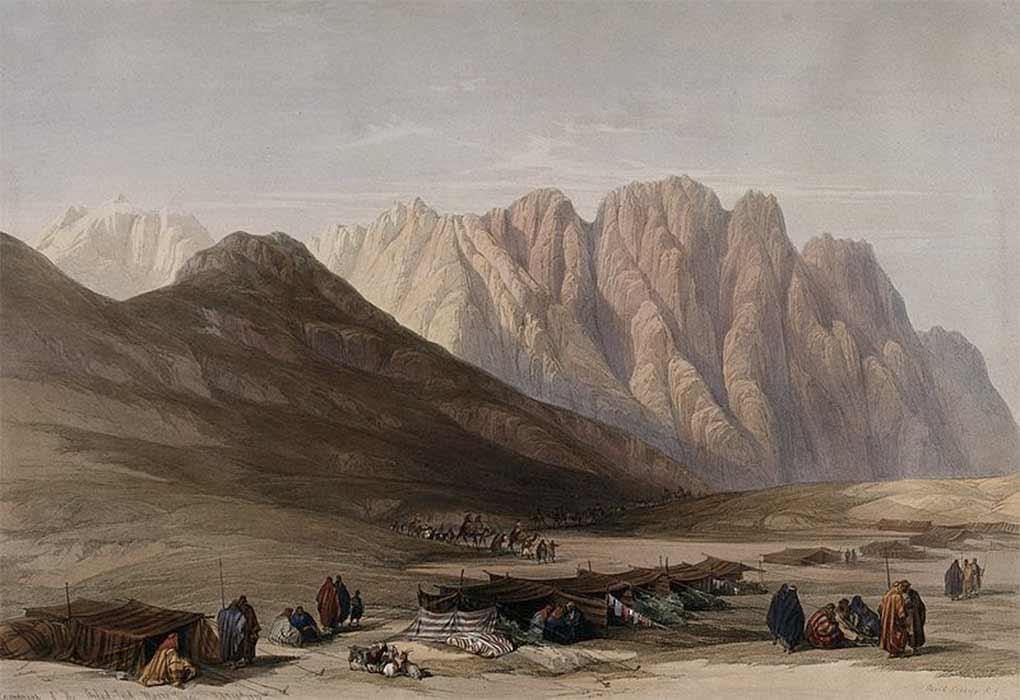
Elusive Mount Sinai, Hidden In Plain Site In Egypt
Many locations have been proposed for the biblical Mount Sinai. One of the latest sites is Jebel Madhbah near Petra, and while this and the classical site for Mount Sinai are all possibilities, there exists a radical new alternative which is more logical, evidential and far more provocative. The rugged desert mountains previously suggested would not get Indiana Jones reaching for his hat and whip, and rushing out of the door - but the latest evidence presented, just might.

Encampment of the Aulad-Sa'id at Mount Sinai. Is this Sinai? (Wellcome Images/ CC BY-SA 4.0)
Why should this mountain be so important to the three Judaic religions, and how did its location become forgotten? The answer to the first question is relatively easy to answer: Mount Sinai was the location where Moses spoke to god. Indeed, it was rumored that the Israelite god actually lived inside this mountain, which would indeed make it special. However, the second question is more difficult to answer. Here is the most sacred mountain of the Israelites, the home of their all-powerful god, and someone simply forgot where it was! Why does Judaeo-Christianity always loose its most important characters and locations? Abraham, Moses, Joseph, King David, King Solomon, Jesus, Mary, and Saul, plus the route of the Exodus, King David's palace and Jesus' tomb - they have all gone missing from the historical and archaeological record for some reason. Are these religions simply forgetful, or are they withholding secrets?
Israelites Are Hyksos
If the latter is the case, then what were the Israelite leadership trying to hide? The answer is contained in Ellis’ books Tempest & Exodus (2002) and Eden in Egypt, (2004) where it is explained that the Israelites were actually the Hyksos pharaohs of Egypt. And yet this radical proposal is not without merit, for it was originally suggested by Josephus Flavius, Judaism’s greatest historian. But if Josephus was correct - and the evidence suggests that he was - then the Israelite Exodus out of Egypt must have been the Hyksos Exodus out of Egypt, just as Josephus claims. This also implies that the original beliefs of Judaism must have had a distinctly Egyptian bias. The Hyksos people venerated nearly the full pantheon of Egyptian gods, and so early Judaism must have been substantially polytheistic before the reforms of Pharaoh Akhenaten took effect. This is confirmed in what the Book of Kings says of King Solomon: “For King Solomon went after Ashtoreth the goddess of the Zidonians, and after Milcom the abomination of the Ammonites ... Then did Solomon build a high place for Chemosh, the abomination of Moab, in the hill that is before Jerusalem, and for Molech, the abomination of the children of Ammon.”

A group of West Asiatic foreigners, possibly Canaanites, labelled as Aamu (ꜥꜣmw), including the leading man with a Nubian ibex labelled as Abisha the Hyksos (Public Domain)
Ashtoreth was a Phoenician version of ‘Ast‘ or Isis, and the Zidonians were the people of Sidon. Milcom is the king of the gods, and since its adherents were the Ammonites, one suspects that this referred to the Egyptian Amon or Amun. And finally, since ‘Kem’ or ‘Kam’ was one of the ancient names for Egypt, it is likely that Kemush was also an Egyptian god. But if early Judaism had an Egyptian flavor, then one should probably be looking for a sacred mountain that would suit Egyptian beliefs.
Descriptions Of Mount Sinai
In order to discover the true location for this revised Egypto-Judaic version of Mount Sinai, one should first obtain a description of both the mountain and its general location. One of the best descriptions comes from the accounts of the first century historian, Josephus Flavius, who says: “When (Moses) said this, he ascended up to Mount Sinai, which is the highest of all the mountains that are in that country, and it is not only very difficult to be ascended by men, on account of its vast altitude, but because of the sharpness of its precipices also; and besides this it was terrible and inaccessible, on the account of the rumor that passed about that god dwelt there.”
- Imperial Measures and the Pyramids
- Star Shaft Pointing - Busted: Debunking the Star Shaft Theory of the Great Pyramid
- Mountain of God: Where was the real Mount Sinai, and the Location of the Ark of the Covenant?
Here is a description of a high and sharp mountain that is difficult to climb. The Bible does not have a very good description of this mountain, but it adds the following: “And thou shalt set bounds unto the people round about, saying, ‘take heed to yourselves, that ye go not up into the mount, or touch the border of it: whosoever touches the mount shall be surely put to death’”. This is a peculiar description of a mountain that one cannot touch the borders of, as though the base of the mountain rose up sharply like the base of a cliff. This mountain also appears to be small enough to cordon off with ropes, so that the people cannot get close enough to touch it. So even though Mount Sinai was the largest mountain in the region it must also have been relatively small, and thrust itself rather dramatically out of the surrounding plains.




